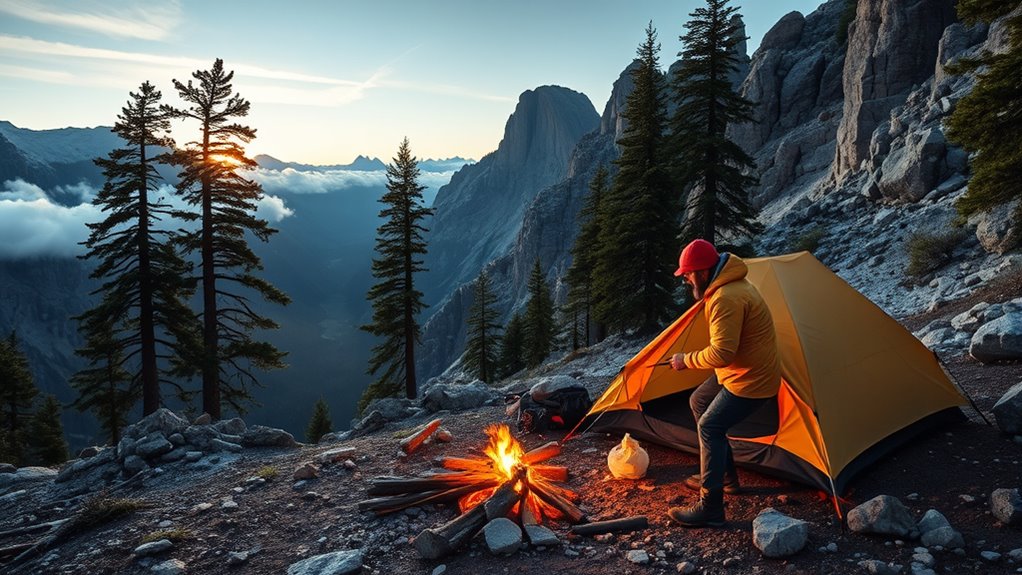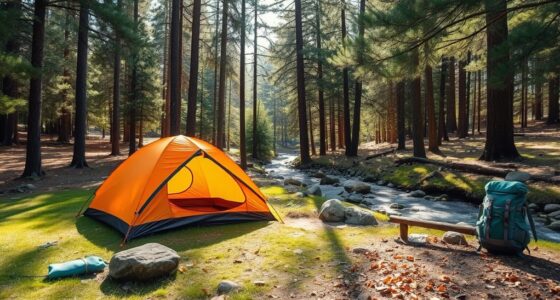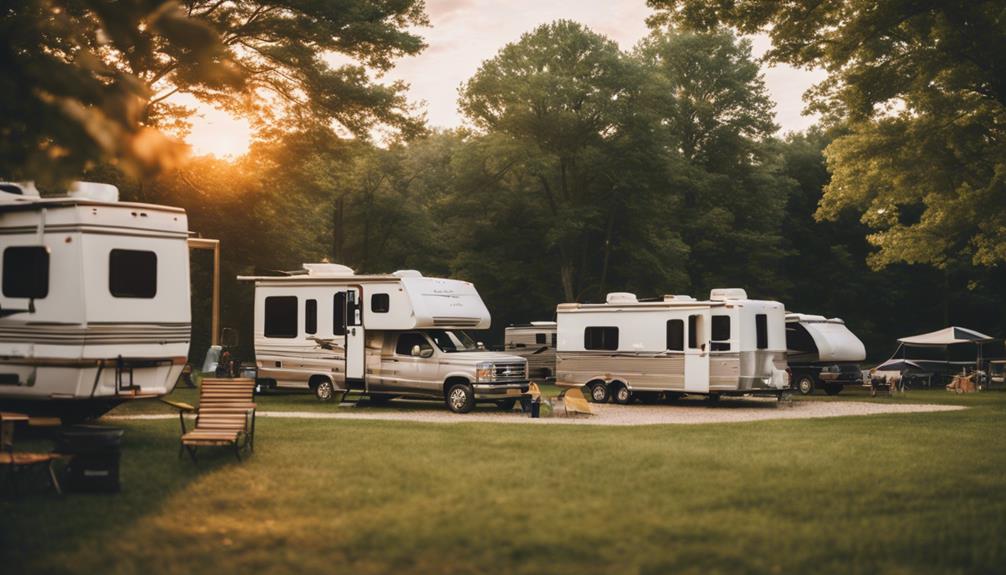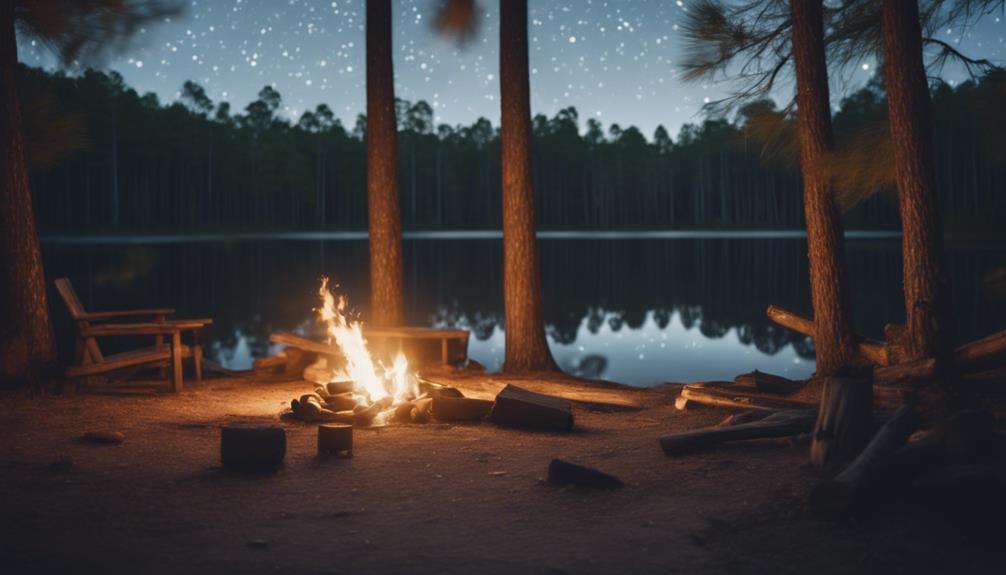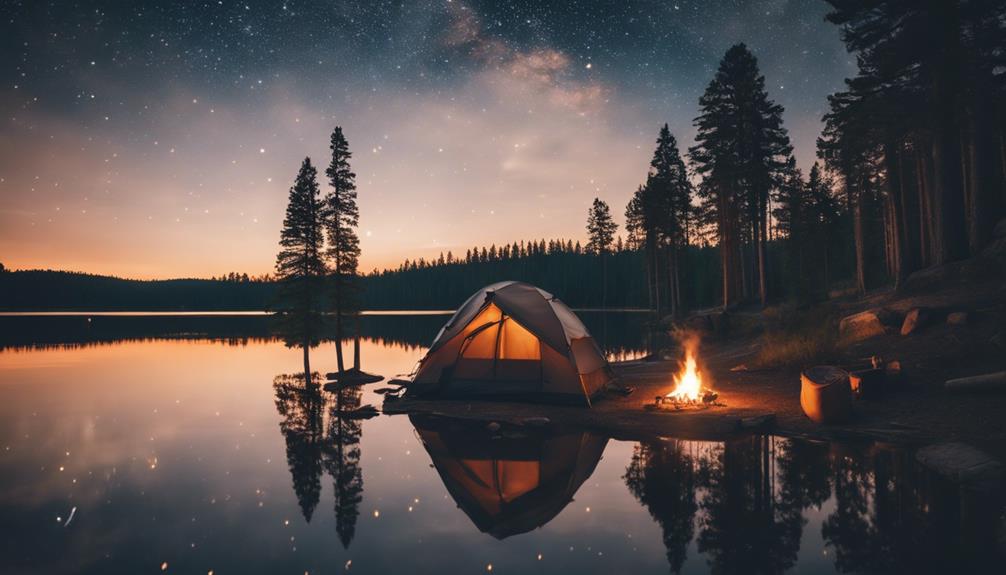When camping in mountains, you must prepare for unpredictable weather and high altitudes by bringing layered clothing, weather-resistant gear, and sufficient supplies. Check forecasts regularly and be ready for sudden storms or temperature drops. Acclimate gradually to avoid altitude sickness, stay hydrated, and recognize early symptoms. Keep your campsite secure and follow safety guidelines for wildlife and fire. Staying vigilant and equipped guarantees your safety; exploring further will reveal how to handle these challenges effectively.
Key Takeaways
- Check weather forecasts regularly and be prepared for sudden changes in mountain conditions.
- Acclimate gradually to high altitudes to prevent altitude sickness.
- Pack layered clothing, waterproof gear, and warm supplies for variable weather.
- Set up camp on stable, well-drained ground away from potential flood zones.
- Carry navigation tools, emergency supplies, and communicate plans before heading into remote areas.
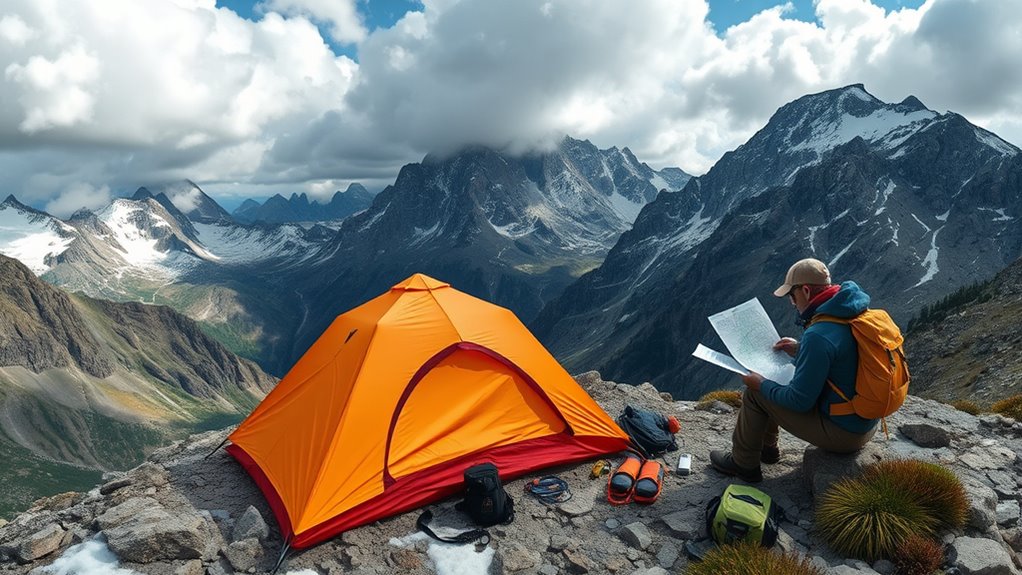
Camping in the mountains offers breathtaking views and a sense of adventure, but it also requires careful preparation and awareness of potential hazards. One of the most important considerations is understanding wildlife encounters. While the thrill of seeing animals in their natural habitat can be memorable, it’s vital to respect their space and avoid provoking them. Always store food securely, preferably in bear-proof containers or hung high out of reach, since bears are common in many mountain regions. Keep your campsite clean by promptly disposing of trash and avoiding leaving food scraps around. Remember, wildlife is usually more interested in natural food sources, but they can become accustomed to human food if you’re careless. This can lead to dangerous encounters, so staying vigilant and maintaining a clean campsite is essential for your safety.
Fire safety is another critical aspect of mountain camping. The dry, often windy conditions found at higher elevations can turn even a small spark into a wildfire threat. Before starting a fire, check local regulations and fire bans, and ensure you’re in a designated fire ring or pit. Never leave a fire unattended, and always keep it manageable—douse it completely with water before sleeping or leaving the area. Be mindful of wind conditions, which can quickly spread flames. Keep firefighting tools nearby, like a bucket of water or a fire extinguisher, and know how to use them. In areas prone to wildfires, it’s wise to avoid making fires altogether, opting instead for portable stoves for cooking. Additionally, be cautious with smoking materials; discard cigarettes in proper containers and never flick a cigarette butt into dry grass or leaves.
Both wildlife encounters and fire safety demand your constant attention and respect for the natural environment. Always educate yourself about the specific wildlife in your camping area and the local fire regulations before setting out. Carry necessary safety gear, such as bear spray, and know how to use it effectively. Keep your campsite organized, free of food smells that might attract animals, and always have a plan for emergency situations. By maintaining a cautious mindset and following best practices, you’ll significantly reduce the risks associated with wildlife interactions and fires, ensuring a safer, more enjoyable mountain camping experience. Remember, respecting nature’s power and unpredictability is crucial—your preparedness can make all the difference.
Frequently Asked Questions
How Can I Prevent Altitude Sickness During Mountain Camping?
To prevent altitude sickness during mountain camping, prioritize proper altitude acclimatization by gradually ascending and allowing your body time to adjust. Follow hydration strategies by drinking plenty of water, avoiding alcohol, and eating high-carbohydrate foods. Monitor your symptoms closely, and if you experience headache, dizziness, or nausea, descend to a lower elevation promptly. Staying cautious and prepared helps you enjoy your adventure safely while minimizing the risk of altitude sickness.
What Are the Best Clothing Layers for Unpredictable Mountain Weather?
You should use layering techniques with moisture-wicking fabrics as your base layer to keep sweat away from your skin. Add an insulating mid-layer like fleece or down for warmth, and top it with a waterproof, windproof outer shell to protect against rain and gusts. This adaptable system allows you to adjust layers quickly in unpredictable mountain weather, ensuring you stay dry, warm, and safe in changing conditions.
How Do I Choose a Safe Campsite at High Elevations?
When selecting a safe high-elevation campsite, look for flat ground away from loose rock formations that could pose hazards. Make certain the site is accessible without traversing steep, unstable terrain. Avoid areas prone to avalanches or rockfalls; opt for sheltered spots with good drainage. Carefully evaluate nearby features, and prioritize sites with clear escape routes. Your goal is a stable, protected location that minimizes risks from weather and geological hazards.
What Emergency Signals Should I Carry for Mountain Weather Issues?
Think of your signals as your voice in the storm. Carry an emergency whistle to cut through the wind’s roar, and a signal mirror to catch distant sunlight, flashing alerts like a beacon of hope. These tools symbolize your resilience and preparedness. Use them judiciously, aiming for visibility and audibility, especially in sudden weather shifts. Staying cautious and ready guarantees you can summon help when the mountain weather turns treacherous.
How Can I Protect My Food From Wildlife in Mountain Areas?
To protect your food from wildlife, use proper food storage techniques like hanging bags in a tree at least 10 feet high and 4 feet away from the trunk or using bear-proof containers. Incorporate wildlife deterrents such as noise makers or spray to keep animals at bay. Always store food away from your sleeping area, and avoid bringing strong-smelling items. This cautious approach minimizes scent attraction and prevents dangerous encounters.
Conclusion
Remember, just as Frodo wisely prepared before crossing Mordor, you must respect mountain weather and altitude. Stay vigilant, pack appropriately, and adapt to changing conditions — nature’s unpredictability can turn swift. Your safety depends on your awareness and preparation, much like a seasoned explorer steering the unknown. By respecting the mountain’s power, you ensure your adventure remains memorable for the right reasons. Stay cautious, stay prepared, and let nature be your guide, not your adversary.

